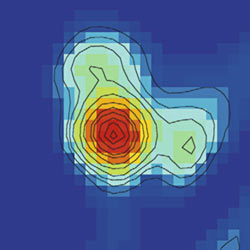
The VLT Interferometer resolved infrared glows from two smoke clouds puffed off by the carbon-rich supergiant star RY Sagittarii. This frame is 0.6 arcsecond on a side.
ESO / P. de Laverny & D. M?©karnia
R Coronae Borealis, easily spotted in binoculars at 6th magnitude, is one of the best-known variable stars that amateur astronomers monitor. It's the prototype for a class of yellow-white, carbon-rich supergiants that shine steadily for months or years on end, then drop without warning to a tiny fraction of their normal brightness and recover gradually, often with relapses along the way.
Many decades ago, astronomers figured out what's probably happening. Puffs of carbon vapor leave the star and condense into soot as they cool, blocking the star from view. In other words, these stars smoke as they burn — literally. This is exactly how smoke forms above a fire on Earth. As the soot clouds move away into space they thin out, letting the star shine through once again.
Recently we got our closest look yet at the process. Using a pair of telescopes in the European Southern Observatory's Very Large Telescope Interferometer, astronomers have detected large, infrared-emitting smoke clouds as close as 30 astronomical units from RY Sagittarii, the sky's number-two R Coronae Borealis star after R Cor Bor itself.
"This is the closest dusty cloud ever detected around an R CrB-type variable since our first direct detection in 2004," writes Patrick de Laverny, leader of the European team involved. "However, it is still detected too far away from the star to distinguish between the different scenarios proposed within the Dust Puff Theory for the possible locations in which the dusty clouds form."
If the cloud moves away from the star at 300 kilometers per second, a reasonable estimate, it was ejected more than six months before the observations.
Background: R Cor Bor stars are very rare, and weirder than they seem: their atmospheres contain almost no hydrogen, even though hydrogen is by far the most common element in the universe. Astronomers could never figure out a stellar-evolution pathway that would lead to such an object.
Then in 2002, Simon Jeffery (Armagh Observatory) and Hideyuki Saio (Tohoku University) found a solution: the merger of a close-orbiting pair of white dwarfs. If one of the dwarfs contains hydrogen, the merger may cause a supernova. But if one of the white dwarfs is made of helium and the other is the carbon-oxygen type, the combined object enlarges to become a relatively normal-looking supergiant star of the correct, weird chemical composition.
Take a look! R Cor Bor itself is currently high overhead in the evening sky for Northern Hemisphere observers. Use binoculars and our comparison-star chart to have a look. Is it currently bright or faint? Then check what you see against the latest reports from members of the American Association of Variable Star Observers (AAVSO).
 1
1
Comments
Paul Shoemaker
August 12, 2007 at 1:01 pm
Don't all stars smoke a little? The stellar wind contains small quantities of heavy elements which eventually coalesce into interstellar grains. The smoke wouldn't become evident until it was compressed by gravity of supernova shocks.
You must be logged in to post a comment.
You must be logged in to post a comment.